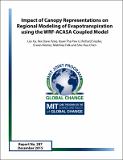| dc.contributor.author | Xu, L. | |
| dc.contributor.author | Pyles, R.D. | |
| dc.contributor.author | Paw U, K.T. | |
| dc.contributor.author | Snyder, R. | |
| dc.contributor.author | Monier, E. | |
| dc.contributor.author | Falk, M. | |
| dc.contributor.author | S.-H., Chen | |
| dc.date.accessioned | 2016-05-23T15:10:43Z | |
| dc.date.available | 2016-05-23T15:10:43Z | |
| dc.date.issued | 2015-12 | |
| dc.identifier.uri | http://hdl.handle.net/1721.1/102610 | |
| dc.description.abstract | In this study, we couple the Weather Research and Forecasting Model (WRF) with the Advanced Canopy-Atmosphere-Soil Algorithm (ACASA), a high complexity land surface model, to investigate the impact of canopy representation on regional evapotranspiration. The WRF-ACASA model uses a multilayer structure to represent the canopy, consequently allowing microenvironmental variables such as leaf area index (LAI), air and canopy temperature, wind speed and humidity to vary both horizontally and vertically. The improvement in canopy representation and canopy-atmosphere interaction allow for more realistic simulation of evapotranspiration on both regional and local scales. Accurate estimates of evapotranspiration (both potential and actual) are especially important for regions with limited water availability and high water demand, such as California. Water availability has been and will continue to be the most important issue facing California for years and perhaps decades to come. Terrestrial evapotranspiration is influenced by many processes and interactions in the atmosphere and the bio-sphere such as water, carbon, and momentum exchanges. The need to improve representation within of surface-atmosphere interactions remains an urgent priority within the modeling community. | en_US |
| dc.description.sponsorship | This work is supported in part by the National Science Foundation under Awards No.ATM-0619139 and EF-1137306. The Joint Program on the Science and Policy of Global Change is funded by a number of federal agencies and a consortium of 40 industrial and foundation sponsors. (For the complete list see http://globalchange.mit.edu/sponsors/current.html). | en_US |
| dc.language.iso | en_US | en_US |
| dc.publisher | MIT Joint Program on the Science and Policy of Global Change | en_US |
| dc.relation.ispartofseries | MIT Joint Program Report Series;287 | |
| dc.title | Impact of Canopy Representations on Regional Modeling of Evapotranspiration using the WRF-ACASA Coupled Model | en_US |
| dc.type | Technical Report | en_US |
| dc.type | Working Paper | en_US |
| dc.identifier.citation | Report 287 | en_US |
